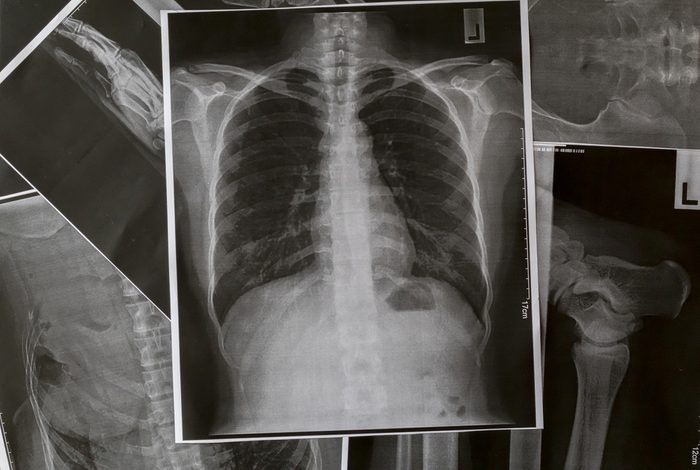
Your body’s defense system
A normal body temperature is 98.6 degrees Fahrenheit; when it hits 100.4 or above, you have a fever. Many times, a fever can be a sign that your immune system is functioning well. Your body heats up because it senses a foreign invader: “Bacterial, viral, or something else that’s not supposed to be there,” says Deborah Nunziato-Ghobashy, DO, family medicine physician at Scarsdale Medical Group. “The hypothalamus in the brain controls your body temperature and raises it to kill off anything that could be invading your body,” she explains. “All those bacteria and viruses prefer a cozy 98.6-degree environment to keep on replicating. Once it’s higher, it’s too hot for them and they start to die off.” Discover exactly what happens to your body when you have a fever. But what about those times your fever is a red flag for something more serious?

Persistant fever
If your fever doesn’t resolve within three days, you should see your doctor, says Dr. Nunziato-Ghobashy. “At that point, you may require antibiotics. You have a fever of unknown origin, and your doctor will start to investigate to see what’s wrong. Most likely it’s an infection that can be found once a trained clinician takes a look at you.”Also, check these cold sore remedies you didn’t know you could make at home.

Pain on the lower right side of your belly
If you have a fever and you start to experience abdominal pain that starts around the belly button but within two hours moves to the right lower quadrant of the abdomen and becomes severe, those are signs you have appendicitis, says Dr. Nunziato-Ghobashy. Appendicitis is typically confirmed with a CT scan and requires surgery to remove the appendix. If the surgery is not performed quickly enough, the appendix can burst and cause infection and even death. Here are some other causes for your lower abdominal pain.

Low back pain and blood in the urine
If you have a fever accompanied by burning pain when you urinate, lower back pain, pelvic pain, blood in the urine, or urine that looks cloudy or smells funny, says Dr. Nunziato-Ghobashy, you may have a urinary tract infection (UTI). When such an infection gets bad, you’ll end up with a fever. Your doctor can take a urine sample to look for white blood cells, red blood cells, or bacteria—all signs of a UTI. Patients typically get medication for the pain as well as an antibiotic to eliminate the infection.

Sore throat
Strep throat is a bacterial infection that’s more common in children than adults. It can cause an intensely sore throat along with a fever and, sometimes, a headache and nausea. “You need to be treated with antibiotics,” says Dr. Nunziato-Ghobashy. And you need to finish all the medication, even after your throat feels better, she warns. “Lingering strep bacteria can cause pericarditis, an infection of the heart valves, which is very serious.”

Digestive disorder
Irritable bowel syndrome, Crohn’s disease, ulcerative colitis, and celiac disease all can trigger an inflammatory response in the body—and that can raise your temperature. “Sometimes fever is the first sign,” says Dr. Nunziato-Ghobashy. And if you alternate between constipation and diarrhea—common among patients with these disorders—the body can react to symptoms of dehydration and raise your temperature, she explains.

Blood clot
If you have a blood clot in your leg, you may get a fever; you’ll also notice tenderness and swelling in the area. “If the clot has moved toward your lungs, you’ll have shortness of breath and a rapid heart rate besides the fever,” says Dr. Nunziato-Ghobashy. A doctor will do a physical exam to check for swelling, and they may also order an ultrasound of the leg to see if there’s a deep vein thrombosis—a clot that can break off and travel to the lungs—which can be deadly.

Joint pain
“Arthritis, especially rheumatoid arthritis, can raise inflammatory markers in the body and cause you to have fevers,” says Dr. Nunziato-Ghobashy. “Sometimes a fever that seems to have an unknown origin can be triggered by arthritis.” You may also have joint pain and body aches. Typically the pain will be felt on both sides of the body and is worse in the morning. It will often be accompanied by insomnia.

Breathlessness, exhaustion
Pneumonia inflames your lungs’ air sacs, which may then fill up with fluid or pus, according to the American Lung Association. The infection can be viral or bacterial. Symptoms, in addition to fever and chills, can include cough with mucus, chest pain, and shortness of breath. Always see a doctor if you suspect you have pneumonia, especially if you are in a high-risk group: children two or younger, adults 65 or older, and people with a chronic health condition or weakened immune system. Asthma sufferers beware: your inhaler may be causing your pneumonia.

Swollen neck, fatigue
Fever, fatigue, swollen lymph nodes in the neck, sore throat, and an enlarged spleen are the hallmark symptoms of Epstein-Barr virus, also known as mononucleosis. Common in childhood, less so among adults, it usually resolves in two to four weeks but can last for months, according to the Centers for Disease Control and Prevention. Your doctor can confirm the diagnosis with a blood test; treatment includes rest, drinking plenty of fluids, and taking OTC medications for pain and fever.

Skin infection
Cellulitis is a common—and serious—bacterial skin infection that often appears on the lower legs but can turn up anywhere on the body or face. It occurs when bacteria infect a break or crack in the skin; at first, you’ll see a swollen, red patch on the skin that is warm and painful to the touch. You may also get a fever, red spots, skin dimpling, and blisters. “The infection can spread quickly if not caught in time,” says Dr. Nunziato-Ghobashy. Seek emergency care if you notice signs of cellulitis. The good news about that infection: it’s one of the things you think are contagious but probably isn’t.

The stomach flu
With gastroenteritis—commonly called the stomach flu—your digestive tract is irritated and inflamed, usually because of a bacterial infection, virus, or parasites. You may experience fever, nausea, chills, vomiting, stomach cramping, and loose stools. Symptoms typically last from two to 10 days and go away by themselves. But if you have been vomiting for longer than two days, you notice blood in your vomit or stool, or you have signs of dehydration, the Mayo Clinic advises seeing a doctor immediately. Infants, older adults, and people with compromised immune systems also need to see a doctor right away.

Cancer
A fever can accompany some cancers, including lymphoma, leukemia, and kidney and liver cancers. “They cause an inflammatory response in the body,” says Dr. Nunziato-Ghobashy. This is rare, she stresses, but something to pay attention to if you have a fever that persists. “If you can’t find a reason for your fever, it’s important to have somebody look to see professionally whether there is a reason.”
